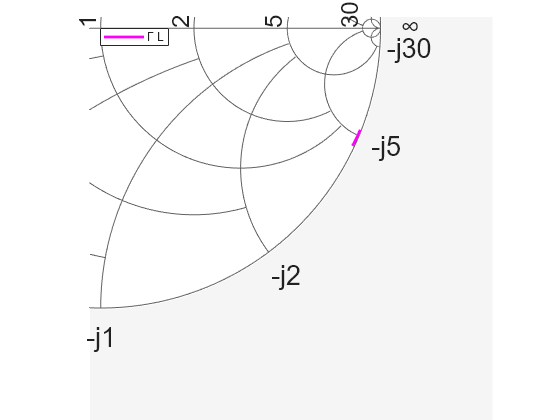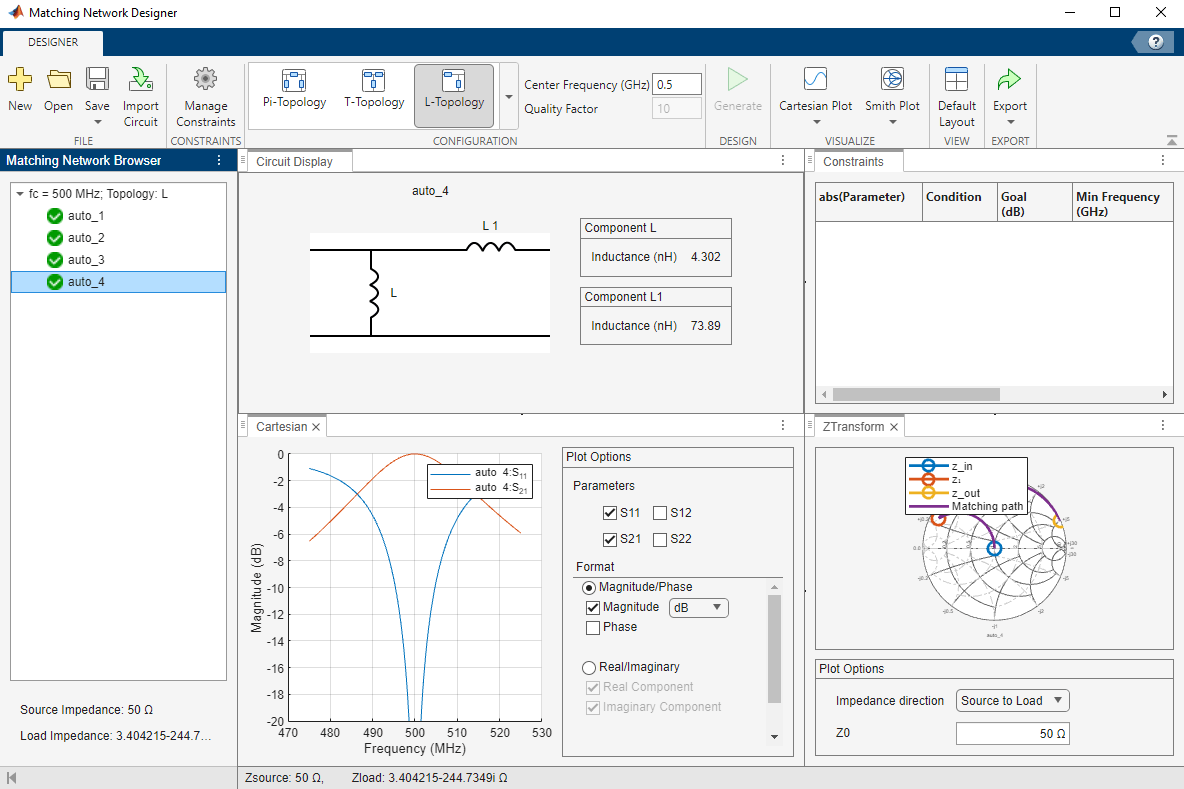Impedance Matching of Small Monopole Antenna
This example shows how to design a double tuning L-section matching network between a resistive source and capacitive load in the form of a small monopole by using the matchingnetwork object. The L-section consists of two inductors. The network achieves conjugate match and guarantees maximum power transfer at a single frequency.
Create Monopole
Create a quarter-wavelength monopole antenna via the Antenna Toolbox with the resonant frequency around 1 GHz. For the purpose of this example, we choose a square ground plane of side .
fres = 1e9; speedOfLight = physconst('lightspeed'); lambda = speedOfLight/fres; L = 0.25*lambda; dp = monopole('Height',L,'Width',L/50,... 'GroundPlaneLength',0.75*lambda,... 'GroundPlaneWidth',0.75*lambda);
Calculate Monopole Impedance
Specify the source (generator) impedance, the reference (transmission line) impedance and the load (antenna) impedance. In this example, the load Zl0 will be the non-resonant (small) monopole at the frequency of 500 MHz, which is the half of the resonant frequency. The source has the equivalent impedance of 50 ohms.
f0 = fres/2; Zs = 50; Z0 = 50; Zl0 = impedance(dp,f0); Rl0 = real(Zl0); Xl0 = imag(Zl0);
Define the number of frequency points for the analysis and set up a frequency band about 500 MHz.
Npts = 30; fspan = 0.1; fmin = f0*(1 - (fspan/2)); fmax = f0*(1 + (fspan/2)); freq = unique([f0 linspace(fmin,fmax,Npts)]);
Understand Load Behavior using Reflection Coefficient and Power Gain
Calculate the load reflection coefficient and the power gain between the source and the antenna.
S = sparameters(dp, freq); GammaL = rfparam(S, 1,1); Gt = 10*log10(1 - abs(GammaL).^2);
Plotting the input reflection coefficient on a Smith chart shows the capacitive behavior of this antenna around the operating frequency of 500 MHz. The center of the Smith chart represents the matched condition to the reference impedance. The location of the reflection coefficient trace around confirms that there is a severe impedance mismatch.
fig1 = figure; hsm = smithplot(fig1,freq,GammaL,'LineWidth',2.0,'Color','m',... 'View','bottom-right','LegendLabels',{'#Gamma L'});

Plot the power delivered to the load.
fig2 = figure; plot(freq*1e-6,Gt,'m','LineWidth',2); grid on xlabel('Frequency [MHz]') ylabel('Magnitude (dB)') title('Power delivered to load')
![Figure contains an axes object. The axes object with title Power delivered to load, xlabel Frequency [MHz], ylabel Magnitude (dB) contains an object of type line.](../../examples/rf/win64/ImpedanceMatchingOfANonresonantSmallMonopoleExample_02.png)
As the power gain plot shows, there is approximately 20 dB power loss around the operating frequency (500 MHz).
Design Matching Network
The matching network must ensure maximum power transfer at 500 MHz. The L-section double tuning network achieves this goal [1]. The network topology, shown in the figure consists of an inductor in series with the antenna, that cancels the large capacitance at 500 MHz, and a shunt inductor that further boosts the output resistance to match the source impedance of 50 .
Use the matchingnetwork object to create various matching network circuits based on the source impedance, load impedance, and center frequency.
matchnw = matchingnetwork('CenterFrequency',f0,'LoadImpedance',Zl0,'Bandwidth',50e6); matchnw.clearEvaluationParameter(1); % clear default constraint
The values of each element for the circuits generated are shown below.
[circuit_list, performance] = circuitDescriptions(matchnw)
circuit_list=4×5 table
circuitName component1Type component1Value component2Type component2Value
___________ ______________ _______________ ______________ _______________
Circuit 1 "auto_1" "Series L" 2.9835e-07 "Shunt L" 1.0551e-07
Circuit 2 "auto_2" "Series C" 3.396e-13 "Shunt L" 6.1873e-08
Circuit 3 "auto_3" "Shunt C" 2.3541e-11 "Series L" 8.1999e-08
Circuit 4 "auto_4" "Shunt L" 4.304e-09 "Series L" 7.3978e-08
performance=4×4 table
circuitName evaluationPassed testsFailed performanceScore
___________ ________________ ____________ ________________
Circuit 1 "auto_1" {["Yes"]} {0×0 double} {[0]}
Circuit 2 "auto_2" {["Yes"]} {0×0 double} {[0]}
Circuit 3 "auto_3" {["Yes"]} {0×0 double} {[0]}
Circuit 4 "auto_4" {["Yes"]} {0×0 double} {[0]}
Create Matching Network and Calculate S-parameters
The matching network circuit is created via the RF Toolbox™ and it consists of the two inductors whose values have been calculated above. The S-parameters of this network are calculated over the frequency band centered at the operating frequency.
Calculate the S-parameters based on desired matching network (this example uses circuit #2).
ckt_no = 4; Smatchnw = sparameters(matchnw, freq, Z0, ckt_no);
The circuit element representation of the matching network is shown below.
disp(matchnw.Circuit(ckt_no))
circuit: Circuit element
ElementNames: {'L' 'L_1'}
Elements: [1×2 inductor]
Nodes: [1 2 3]
Name: 'auto_4'
Reflection Coefficient and Power Gain with Matching Network
Calculate the input reflection coefficient/power gain for the antenna load with the matching network.
Zl = impedance(dp,freq);
GammaIn = gammain(Smatchnw,Zl);
Gtmatch = powergain(Smatchnw,Zs,Zl,'Gt');
Gtmatch = 10*log10(Gtmatch);Compare Results
Plot the input reflection coefficient and power delivered to the antenna, with and without the matching network. The Smith® chart plot shows the reflection coefficient trace going through its center thus confirming the match. At the operation frequency of 500 MHz, the generator transfers maximum power to the antenna. The match degrades on either side of the operating frequency.
add(hsm,freq,GammaIn);
hsm.LegendLabels(2) = {'#Gamma In'};
hsm.View = 'full';
Plot power delivered to the load.
figure(fig2) hold on plot(freq*1e-6,Gtmatch,'LineWidth',2); axis([min(freq)*1e-6,max(freq)*1e-6,-25,0]) legend('No matching network','Double tuning','Location','Best');
![Figure contains an axes object. The axes object with title Power delivered to load, xlabel Frequency [MHz], ylabel Magnitude (dB) contains 2 objects of type line. These objects represent No matching network, Double tuning.](../../examples/rf/win64/ImpedanceMatchingOfANonresonantSmallMonopoleExample_05.png)
Matching Network Designer
The Matching Network Designer app allows to design matching networks or view an existing matchingnetwork object. Type this command at the command line to open the Matching Network Designer app. Use the matchnw object and select auto_4 node to view the corresponding circuit.
matchingNetworkDesigner(matchnw)

References
[1] M. M. Weiner, Monopole Antennas, Marcel Dekker, Inc.,CRC Press, Rev. Exp edition, New York, pp.110-118, 2003.